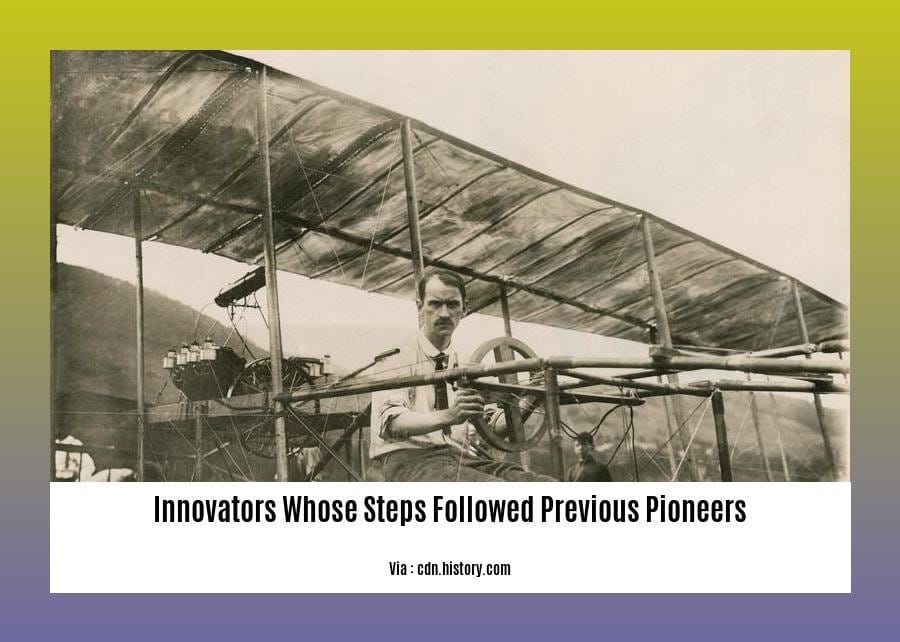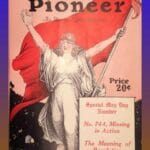**Innovators Whose Steps Followed Previous Pioneers: The Importance of Standing on the Shoulders of Giants**
Throughout history, innovators have stood on the shoulders of giants, building upon the work of their predecessors to achieve even greater heights. From the Wright brothers to Steve Jobs, these innovators have been inspired by the past and have used it to fuel their own creativity. In this article, we will explore the ways in which today’s innovators have built upon the work of their predecessors, and the impact their work has had on our world.
Key Takeaways:

- Innovators build upon the work of predecessors, improving and expanding upon existing ideas.
- Innovation requires recognizing the potential applications of inventions beyond their original intent.
- Notable innovators include Cai Lun (paper), Thomas Edison (electricity), Madam C.J. Walker (hair care), John Deere (agriculture), and Steve Jobs (technology).
- Great innovators often have a deep understanding of the broader implications of their work.
Innovators Whose Steps Followed Previous Pioneers
When recounting numerous breakthroughs that transformed human existence, we consistently encounter a pertinent question: do inventors generate groundbreaking concepts on their own, or do they leverage the insights of those who came before them? History eloquently responds by presenting us with innovators whose steps followed previous pioneers, highlighting the importance of standing on the shoulders of giants.
A Tapestry of Ingenuity: Building upon the Past
The annals of innovation are replete with examples of individuals who recognized that true progress rarely occurs in isolation. Cai Lun, the Chinese scholar who revolutionized communication in 105 A.D. with his invention of paper, drew inspiration from ancient processes of fabricating papyrus. His innovation was not a radical departure from the past but rather a refinement built upon existing knowledge.
The Ripple Effect: Unforeseen Applications
Innovation often entails recognizing potential uses beyond the original intent. Thomas Edison’s incandescent light bulb, for example, had its roots in the carbon arc lamp invented by Humphry Davy. Edison’s genius lay in refining the technology and envisioning its widespread societal impact. Similarly, Madam C.J. Walker, inspired by her own struggles with hair loss, developed a line of hair care products that empowered African American women and laid the foundation for a flourishing beauty industry.
Embracing the Legacy: Giants Among Us
The greatest innovators often possess the humility to acknowledge their debt to those who preceded them. John Deere, the American inventor, transformed agriculture through his steel plow, but he was quick to credit earlier inventors like Jethro Wood for their contributions. Steve Jobs, the visionary behind Apple, was profoundly influenced by the work of Alan Kay and his team at Xerox PARC. Jobs recognized that innovation is not about reinventing the wheel but about building upon the best ideas of the past.
Pioneers of the Digital Age: Envisioning the Future
In the rapidly evolving world of technology, we see countless examples of innovators whose steps followed previous pioneers. Tim Berners-Lee, the inventor of the World Wide Web, drew inspiration from earlier developments like ARPANET and hypertext systems. His vision transformed the way we communicate, access information, and connect with the world. Larry Page and Sergey Brin, the founders of Google, built upon the mathematical foundations of PageRank to create one of the most powerful and influential search engines in history.
The Importance of Standing on the Shoulders of Giants
To truly appreciate the significance of innovators whose steps followed previous pioneers, it’s essential to understand the complexities of the innovation process. It involves meticulous research, experimentation, and incremental improvements. By recognizing the milestones achieved by those who came before them, innovators can avoid duplicating efforts and accelerate their progress. The notion of “standing on the shoulders of giants” underscores the collaborative nature of innovation and reminds us that the greatest breakthroughs often emerge from a tapestry of shared knowledge and inspiration.
Innovators whose steps followed pioneers who built on prior innovations and then visionaries who advanced pioneering work to establish the pioneering progress erected on pioneering foundations.
The Global Community for Entrepreneurs
The Global Community for Entrepreneurs is a network of professionals dedicated to supporting and connecting entrepreneurs worldwide. This community provides resources, guidance, and mentorship to foster innovation and economic development.
Key Takeaways:
- Entrepreneurs are constantly building upon the work of their predecessors.
- Innovation is a collaborative process that requires the sharing of ideas and resources.
- The Global Community for Entrepreneurs is a valuable resource for entrepreneurs worldwide.
Conclusion
The Global Community for Entrepreneurs is a vital part of the innovation ecosystem. By providing support and resources to entrepreneurs, this community can help accelerate economic development and create a more prosperous future for all.
Citation:
World Economic Forum. (2023, June 29). Leaders Call for Innovation, Entrepreneurship and Global Cooperation to Address Global Economic Concerns. [Press release].

FAQ
Q1: Who are some of the most famous innovators in history?
A1: Some of the most famous innovators in history include Thomas Edison, Madam C.J. Walker, John Deere, and Steve Jobs.
Q2: How have innovators built upon the work of their predecessors?
A2: Innovators have built upon the work of their predecessors by improving existing ideas and recognizing potential applications beyond the original intent.
Q3: What are some of the challenges that innovators have faced?
A3: Some of the challenges that innovators have faced include lack of funding, skepticism, and competition.
Q4: What are the lessons that innovators have learned?
A4: Some of the lessons that innovators have learned include the importance of perseverance, collaboration, and risk-taking.
Q5: What is the impact that innovators have had on our world?
A5: Innovators have had a profound impact on our world by improving our quality of life, creating new industries, and shaping the future.
















